by Bruce Wells | Sep 2, 2024 | This Week in Petroleum History
September 2, 1910 – Cities Service Company incorporates –
Henry Doherty organized the Cities Services Company as a public utility holding company in Bartlesville, Oklahoma. Doherty bought producing properties in Kansas and Oklahoma as he acquired distributing companies and linked them to natural gas fields.
In 1915, a Cities Service subsidiary discovered the 34-square-mile El Dorado oilfield. In 1928, another subsidiary completed the discovery well of the Oklahoma City oilfield.

Cities Service Company subsidiaries discovered major Mid-Continent oilfields.
Federal court mandates in 1940 resulted in Cities Service’s divestiture of its public utilities, and in 1959 the remaining companies were reformed as Cities Service Oil Company, which changed its marketing brand to Citgo in 1964.
After being acquired by Occidental Petroleum in 1982, Citgo was acquired by the Venezuela state-owned oil company Petróleos de Venezuela (PDVSA) in 1990.
Learn more in Cities Service Company.

September 2, 1918 – Desdemona Oilfield adds to North Texas Boom
A third oil boom arrived in Eastland County, Texas, when the Hog Creek Oil Company exploratory well at Desdemona blew in at 2,000 barrels of oil a day — thrilling the venture’s investors. Production from the new oilfield, which joined prolific fields at Breckenridge (1916) and “Roaring Ranger” (1917), would peak at more than 7.3 million barrels of oil in 1919.
“By 1919 the Desdemona field was probably the second largest in the oil belt, and the Hog Creek Oil Company’s stockholders were able to sell their $100 shares for $10,250 each,” noted Edwin Cox in his 1950 History of Eastland County, Texas.
Thanks to its oil leases, Eastland County’s Merriman Baptist Church would be declared the richest congregation in America.
September 2, 2009 – Gulf of Mexico Depth Record
BP discovered an oilfield 250 miles southeast of Houston in the Gulf of Mexico — and set a world depth record by drilling 30,923 feet into seabed from a platform floating more than 4,130 feet above.
The Tiber Prospect field — in 2009 estimated to contain more than three billion barrels of oil — was drilled by the Deepwater Horizon, which later was moved to a new site and destroyed in the deadly explosion and oil spill of April 2010. Learn about other ultra-deep wells in Anadarko Basin in Depth.
September 4, 1841 – “Rock Drill Jar” Patent for Percussion Drilling
Early drilling technology advanced when William Morris, a driller in West Virginia, patented a “Rock Drill Jar.” It was an innovation he had been experimenting with while drilling brine wells.
“The mechanical success of cable-tool drilling has greatly depended on a device called jars, invented by a spring pole driller,” according to historian Samuel Pees, who in 2004 noted Morris began using the technology as early as the 1830s.
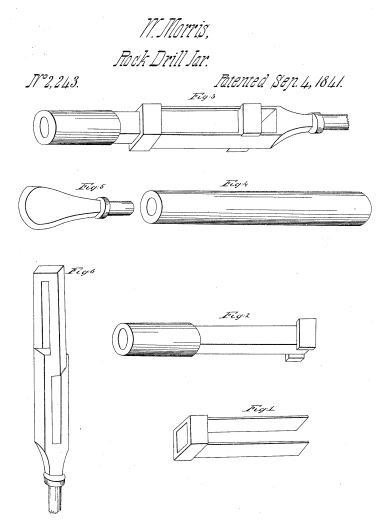
Drill jar technology improved efficiency for drilling brine wells — and later, oil wells.
For more advanced cable tools, Morris patented a “manner of uniting augers to sinkers for boring,” with the upper link of the jars helping the lower link to strike the underlying auger stem on the upstroke. This upward blow could dislodge the bit if it was stuck in the rock formation. Cable-tool drillers would soon improve upon Morris’ patented jars.
Learn more in Making Hole — Drilling Technology.

September 4, 1850 – Illuminating Chicago Streets
The Chicago Gas Light & Coke Company delivered its first commercial gas processed from coal. “The gas pipes were filled, and the humming noise made by the escaping gas at the tops of the lamp-posts indicated that everything was all right,” reported the Gem of the Prairie newspaper. “Shortly afterward the fire was applied and brilliant torches flamed on both sides of Lake Street as far as the eye could see and wherever the posts were set.”
By 1855, almost 80 miles of pipeline would be installed for about 2,000 manufactured gas consumers in Chicago. The first U.S. public street lamp fueled by manufactured gas illuminated Baltimore, Maryland, in 1817 (see Illuminating Gaslight).
September 5, 1885 – Birth of the “Filling Station” Gas Pump
Modern gasoline pump design began with inventor Sylvanus F. (Freelove) Bowser, who sold his first pump to a grocery store owner in Fort Wayne, Indiana. Designed to safely dispense kerosene as well as “burning fluid, and the light combustible products of petroleum,” Bowser’s pump included a container holding 42 gallons. The pump used marble valves, a wooden plunger, and a simple, upright faucet.
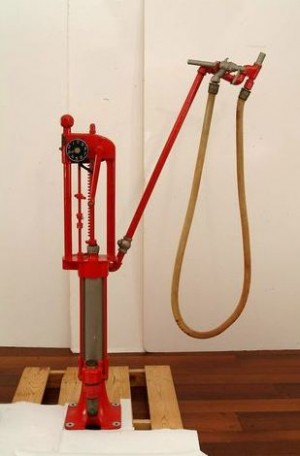
The 1916 Bowser gas pump included a “clock face” dial to measure pumped gas. Photo courtesy Smithsonian Institution.
Thanks to the pump’s success at Jake Gumper’s grocery store, Bowser formed the S.F. Bowser Company and patented his invention in 1887. Within a decade — as the automobile’s popularity grew — Bowser’s company has added new pump designs. By 1905, the S.F. Bowser “Self-Measuring Gasoline Storage Pump” became known to motorists as a “filling station.”
The Bowser gas pump included a hand-levered suction pump and a hose attachment for dispensing gas. As other pump manufacturers arrived, Fort Wayne became known as the “Gas Pump Capital of the World.”
Learn more in First Gas Pump and Service Station.
September 5, 1927 – Schlumberger Brothers test Electric Logging Tool
An electric well-logging tool was first applied at Pechelbronn, France, after brothers Conrad and Marcel Schlumberger modified their surface system to operate vertically in a well.
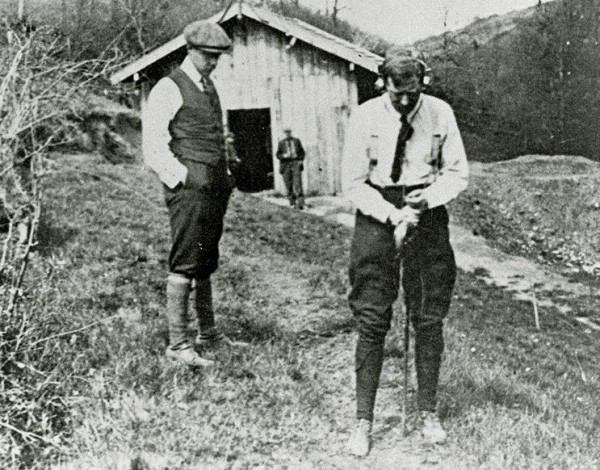
Conrad Schlumberger, using very basic equipment, in 1912 recorded the first map of equipotential curves near Caen, France.
Conrad Schlumberger had conceived the idea of using electrical measurements to map subsurface rock formations as early as 1912. After developing an electrical four-probe surface approach for mineral exploration, the brothers created the electric downhole well log.
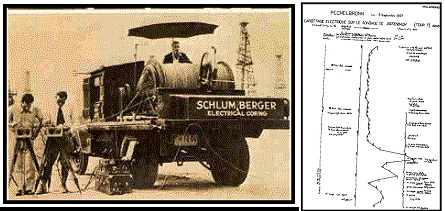
Conrad and Marcel Schlumberger tested their electronic logging tool in 1927, one year after founding the world’s first well-logging company. Photo and image courtesy Schlumberger Ltd.
Lowering their new tool into a well, they recorded a single lateral-resistivity curve at fixed points in the well’s borehole and graphically plotted the results against depth — creating a well log of geologic formations. Changes in subsurface resistance readings showed variations and possible oil and natural gas-producing areas.
The brothers’ technological breakthrough would lead to Schlumberger becoming the world’s first well-logging oilfield service company.
September 5, 1939 – Young Geologist reveals Mississippi Oilfield
Union Producing Company completed its Woodruff No. 1, the first commercial oil well in Mississippi. Drilled at Tinsley, southwest of Yazoo City, the well produced 235 barrels of oil a day from a depth of 4,560 feet in a sandstone later named the Woodruff Sand. Fieldwork by geologist Frederic Mellen led to the Tinsley oilfield discovery.

Fred Mellen was elected president of the Mississippi Geological Survey in 1946.
While working on a Works Progress Administration (WPA) project, Mellen earlier found indications of a salt dome structure similar to the giant Spindletop field of 1901 in Texas. The 28-year-old geologist urged more seismographic testing, and Houston-based Union Producing Company leased about 2,500 acres at Perry Creek.
Mellen’s original WPA project had been a clay and minerals survey, “to locate a suitable clay to mold cereal bowls and other utensils for an underprivileged children’s nursery.” Instead, he launched Mississippi’s oil industry.
Learn more in First Mississippi Oil Wells.

September 7, 1917 – Oilfield Legacy of Texas Governor Hogg
After drilling 20 dry holes, the Tyndall-Wyoming Oil Company completed the No. 1 Hogg well 50 miles south of Houston. Within four months, a second well was producing about 600 barrels a day. The discoveries ended a succession of dry holes dating back to 1901 — when former Texas Governor James “Big Jim” Hogg paid $30,000 for the lease. He also helped launch the Texas Company (Texaco).
Gov. Hogg died 11 years before the Tyndall-Wyoming Oil Company wells found oil in the giant West Columbia oilfield. Fortunately for his family, he stipulated in his will that the mineral rights should not be sold for at least 15 years after his death.
Learn more in Governor Hogg’s Texas Oil Wells.
September 7, 1923 – California Oilfield discovered at Dominguez Hills
Maj. Frederick Russell Burnham discovered oil in Dominguez Hills, an unincorporated area of Los Angeles County, California. His well produced about 1,200 barrels of oil a day from a depth of about 4,000 feet. Maj. Burnham, a decorated soldier in both the U.S. and British armies, was once known as “King of the Scouts.”
The Burnham Exploration Company and partner Union Oil Company of California opened the Dominguez Hills oilfield, “a two-square-mile, two-mile deep stack of eight producing zones.”
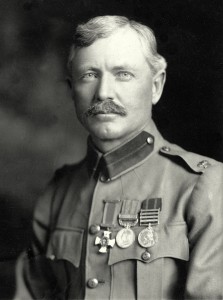
Maj. Frederick R. Burnham in his British Army uniform, 1901.
The region was named for a Spanish soldier who in 1784 received a land grant for grazing cattle. “But family fortunes truly took off with discovery of oil in the 1920s, first in the Torrance area and then, most resoundingly, on Dominguez Hill itself,” explained a California State University historian in 2007.
By 1933, Maj. Burnham’s petroleum exploration venture and Union Oil had paid more than $10 million to stockholders.
Learn more California history in First California Oil Wells and Discovering Los Angeles Oilfields.

September 8, 1891- Patent issued for “Flexible Driving Shafts”
The modern concept of horizontal drilling may have begun with 19th-century patents by John Smalley Campbell of London. After receiving a British patent for his “useful improvements in flexible driving shafts or cables” in 1889, Campbell received a U.S. patent (no. 459,152) for his drilling method.
While Campbell described the patent as ideal for dental engines, “the patent also carefully covered use of his flexible shafts at much larger and heavier physical scales,” reported oil historian Stephen Testa in a 2015 article for Pacific Petroleum Geology. “The modern concept of non-straight line, relatively short-radius drilling dates back at least to September 8, 1891.”
_______________________
Recommended Reading: The fire in the rock: A history of the oil and gas industry in Kansas, 1855-1976 (1976); Early Texas Oil: A Photographic History, 1866-1936
(1976); Early Texas Oil: A Photographic History, 1866-1936
 (2000); History Of Oil Well Drilling
(2000); History Of Oil Well Drilling (2007); Street Lights of the World
(2007); Street Lights of the World (2015); Vertical Reefs: Life on Oil and Gas Platforms in the Gulf of Mexico
(2015); Vertical Reefs: Life on Oil and Gas Platforms in the Gulf of Mexico (2015); Drilling Technology in Nontechnical Language
(2015); Drilling Technology in Nontechnical Language (2012); An Illustrated Guide to Gas Pumps
(2012); An Illustrated Guide to Gas Pumps (2008); Schlumberger: The History of a Technique
(2008); Schlumberger: The History of a Technique (1978); Oil in the Deep South: A History of the Oil Business in Mississippi, Alabama, and Florida, 1859-1945
(1978); Oil in the Deep South: A History of the Oil Business in Mississippi, Alabama, and Florida, 1859-1945 (1993); California State University, Dominguez Hills
(1993); California State University, Dominguez Hills (2010). Your Amazon purchase benefits the American Oil & Gas Historical Society. As an Amazon Associate, AOGHS earns a commission from qualifying purchases.
(2010). Your Amazon purchase benefits the American Oil & Gas Historical Society. As an Amazon Associate, AOGHS earns a commission from qualifying purchases.
_______________________
The American Oil & Gas Historical Society (AOGHS) preserves U.S. petroleum history. Please become an annual AOGHS supporter today. Help us maintain this energy education website and expand historical research. For more information, contact bawells@aoghs.org. Copyright © 2024 Bruce A. Wells. All rights reserved.
by Bruce Wells | Feb 1, 2021 | Petroleum Companies
Speculators once again converged on a small town in Eastland County in 1918 as yet another West Texas drilling boom began with a gusher. Spear Oil Company soon joined them.
In September a well producing 2,000 barrels of oil a day had blown in near Desdemona, one of the first Texas towns established west of the Brazos River.

The Desdemona oilfield, Eastland County, Texas, circa 1919. Library of Congress Prints and Photographs Division, Washington, D.C.
Desdemona had once been called Hog Town and Hog Creek Oil Company made the discovery (not a skilled conman’s Hog Creek Carruth Oil Company). Eastland County’s Ranger and Cisco communities experienced drilling booms the previous year.
The “Roaring Ranger” McClesky No. 1 well of October 1917 had reached a daily production of 1,700 barrels. Within two years eight refineries were open or under construction and Ranger banks had $5 million in deposits. ALso in North Texas, a 1918 gusher created boom town Burkburnett.
That oil field gained international fame for Ranger as the town that wiped out oil shortages during World War I, allowing the Allies to “float to victory on a wave of oil.” Eastland County’s Cisco would later gain fame as the crowded boom town Conrad Hilton visited after the war — and bought his first motel (see Oil Boom brings First Hilton Hotel).
Spear Oil Company
Spear Oil Company organized with capitalization of $1.75 million in 1919 — the same year the Desdemona field reached its peak annual production of almost 7.4 million barrels of oil.
With J.A. Spear as president and leases to drill in Desdemona, widespread promotion of stock sales was necessary to fund the of Stephensville, Texas, based new venture’s operations. But at least one oil stock promoter who had misrepresented the value of the region’s wells in 1914 was serving time in federal prison.
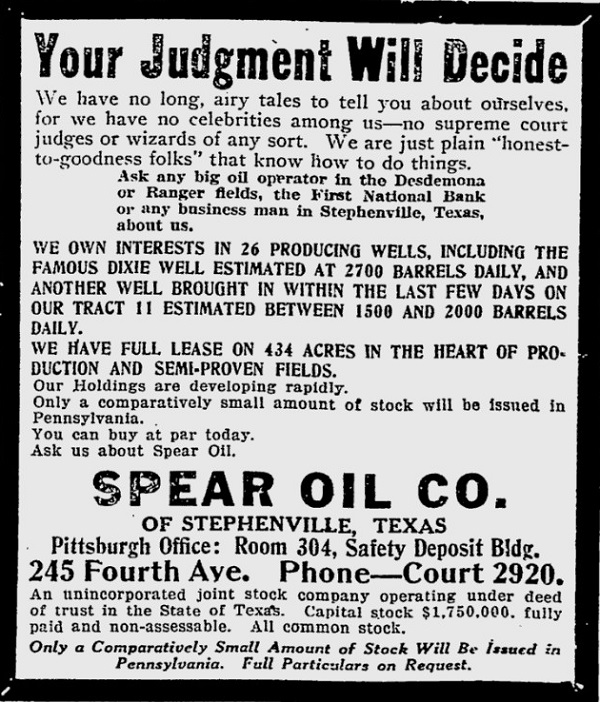 With oil stock promotions appearing in newspapers nationwide, states began taking action. In August 1919, the attorney general of South Carolina refused Spear Oil Company’s request to sell stock in his state because the company failed to comply with South Carolina “Blue Sky Laws.”
With oil stock promotions appearing in newspapers nationwide, states began taking action. In August 1919, the attorney general of South Carolina refused Spear Oil Company’s request to sell stock in his state because the company failed to comply with South Carolina “Blue Sky Laws.”
These new laws were designed to prevent the use of the U.S. Mail in stock promotion schemes. The South Carolina attorney general’s rejection excoriated the practice of “selling script or certificates of so-called ‘stock’ in the leasing and operation of what is claimed to be prospective development, producing and marketing of oil and gas in Texas.”
The trade publication United States Investor agreed. “We do not recommend Spear Oil as a purchase,” noted the magazine’s editors. “Apparently the people at the head of this company are much more at home selling stock than they are in operating an oil enterprise.”
Nonetheless, within a few months, a Wilmington newspaper published an “editorial” letter (no doubt paid for by the company) extolling Spear Oil Company properties.
Newspaper Ads and Editorials
“There are a number of wells being drilled on their royalties and several locations for wells on their solid leases,” the Wilmington Morning Star reported. “As a whole, we consider the securities of Spear Oil Company safe, with prospects for at least good, substantial dividends for many years and each of us has purchased a number of shares of their securities.”
The letter concluded: “In conclusion, we found the conditions and general outlook for the success of the company much better than we had expected, and even better than it had been represented to us. Respectfully submitted…”
Spear Oil did drill in Eastland County and complete oil wells. United States Investor was obliged to update and report net production of about 600 to 650 barrels per day from the company’s Desdemona operations in the southeast corner of Eastland County.
The company’s stock was still offered on the Fort Worth Exchange at $1.40 a share in September 1920, although it had not paid dividends and, “as yet and appears to be using its earnings for further development.” As far away as North Tonawanda, New York, promoters of Spear Oil wrote enthusiastic endorsements recommending the company’s stock.
Drilling a Well
In 1921, Spear Oil Company spudded its Blankenship No. 1 well, but soon shut it down and moved two strings of tools and three rigs to begin operations on another promising lease. The Blankenship No. 2 well’s progress was noted in oil trade publications.
“The Desdemona field now has approximately 315 completed wells that have a daily average production ranging from 4,000 to 6,000 barrels,” Oil Weekly reported on January 14, 1922.
“During the past week, the Spear Oil Company’s No. 2 Blankenship failed to show up as a producer after being shot with 20 quarts from 3,060 to 3,070 feet,” the publication added. “This well has a total depth of 3,085 feet, and is now being cleaned out.”
Learn more how a well was “shot” in Shooters – A Fracking History.
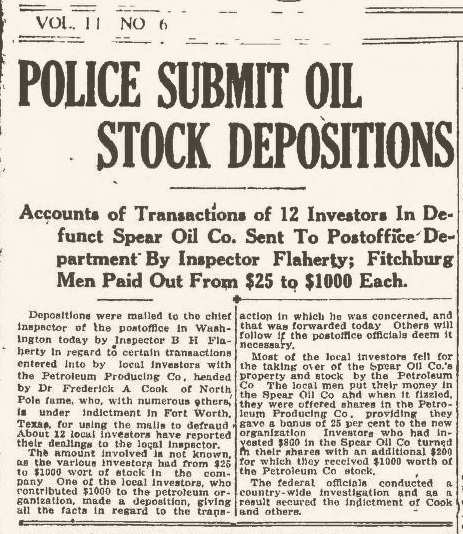
Meanwhile, the impact of over-drilling was clear as reservoir pressures and production from the field diminished. Spear Oil’s Blankenship No. 2 well failed along with many others and funding for continued operations could not be secured.
Stockholders of the failing Spear Oil Company were approached in 1923 by the famed (but fraudulent) North Pole explorer, Frederick Cook and his Petroleum Producers’ Association.
Cook’s stock manipulations and violations of blue sky laws ultimately landed him in prison, but not before many Spear Oil share owners were conned into exchanging their stock for Petroleum Producers’ Association while paying a 25 percent “bonus.”
Learn more about Cook in Arctic Explorer turns Oil Promoter.
Petroleum Producers’ Association stock was as worthless as Spear Oil Company’s, but investors were convinced otherwise, largely through the extraordinary promotional machinations of Seymour Cox. “Alphabet” Cox. The skilled huckster and others were convicted of ”dispersing stock-sales revenues as dividends, claiming income from non-producing wells, and otherwise misrepresenting the company’s position.”
Another notable fraudster, J.W. “Hog Creek” Carruth, created Pilgrim Oil Company and other shady oilfield ventures solely to bilk unwary investors.
It was not until 1934 that the Securities and Exchange Commission (SEC) was established to regulate the issue and sale of securities and to protect the public from increasingly clever stock promotions and manipulations. By then, Spear Oil Company was long gone. Its stock certificates may have value to scripophily collectors.
_______________________
The American Oil & Gas Historical Society preserves U.S. petroleum history. Join today as an annual AOGHS annual supporting member. Help maintain this energy education website and expand historical research. For more information, contact bawells@aoghs.org. Copyright © 2021 Bruce A. Wells. All rights reserved.
Citation Information – Article Title: “Spear Oil Company.” Authors: B.A. Wells and K.L. Wells. Website Name: American Oil & Gas Historical Society. URL: https://aoghs.org/oil-almanac/oil-riches-of-merriman-baptist-church. Last Updated: September 7, 2021. Original Published Date: February 1, 2014.
.
by Bruce Wells | Mar 11, 2014 | Petroleum Companies
Exploring the companies and Ponzi schemes of a 1920s fake oilman.
Wherever men meet “to tell stories of great achievements of the gigantic industry, someone will always tell, amid a breathless silence, the amazing story of Hog Creek Carruth.”
He called himself J.W. “Hog Creek” Carruth. The investors he betrayed do doubt called him much worse. His “amazing story” began in a Texas boom town.
Hog Creek Carruth Oil Company was one of several Texas exploration companies created by Carruth, who gained his nickname after falsely claiming to have discovered the giant Desdemona oilfield at Hogg Creek.
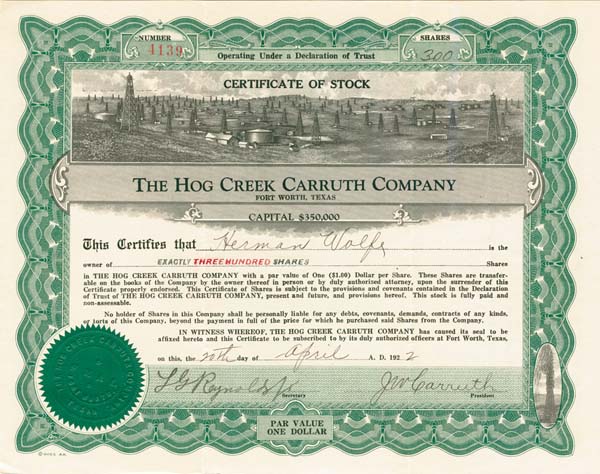
The Hog Creek Carruth Company was among several 1920s companies formed to take advantage of unwary investors seek petroleum wealth in Eastland County, Texas.
In fact, it was Tom Dees and the Hog Creek Oil Company that brought in Desdemona’s discovery well on September 2, 1918. The historic well blew in at 2,000 barrels of oil a day, delighting company investors, who reportedly profited more than $100 for every dollar they had invested. Carruth was among them.
“Hog Creek” Carruth, Stock Promoter
Located along Hog Creek and once called Hogtown, abundant oil production caused Desdemona to boom — and speculators to swarm. As it revelled in its newfound wealth, the town earned a nasty reputation. Texas Rangers had to intervene to keep order. Carruth’s relentless self-promotion and exuberant claims about the discovery soon earned him the “Hog Creek” Carruth moniker.
“The tiny peanut-farming hamlet of Desdemona in Eastland County was transformed when oil was struck in 1918,” notes the Texas State Library and Archives Commission. “Tents and shacks sprang up all around the town to house speculators and workers who flocked to the area, and the population grew from 340 to 16,000 almost overnight.”

Awash with prosperity, people and mud, by April 1920 the Texas Rangers had to be sent into Desdemona to keep order in the oil boomtown.
A contemporary account of the boom reported, “tales of Hogtown during the wicked oil days are too lurid for these pages, but we can say that its debauchery might be so well remembered because so much of it supposedly took place in broad daylight and sometimes not in private.”
Similar Texas drilling booms were taking place in Burkburnett along the Red River and in nearby Ranger, where the “Roaring Ranger” of October 1917 was Eastland County’s first gusher. Read more in Pump Jack Capital of Texas.
With speculators eager to profit from Desdemona, Carruth formed the J. W. Carruth Oil Company in 1919. Despite drilling several dry holes, he profited from selling his exuberantly advertised company stock.
However, just one year after its discovery, the Desdemona oilfield’s production would reach its peak of 7,375,825 barrels and then drop sharply, chiefly because of over drilling, according to the Texas State Historical Association.
Profiting from “Sucker Lists”
J.W. Carruth and his oil company prospered in 1919 by becoming a Ponzi scheme in which Carruth used naïve investors’ purchase money to pay dividends, thereby luring more buyers in a spiral which lined his pockets while emptying theirs. He personally profited by selling his buyers’ personal information.
“Sucker lists” with names, addresses and investment history of people who might buy oil shares had great value. The lists expanded during the multiple oil booms in Eastland County – and similar discoveries in Oklahoma, Kansas and California.
“Depending on the extent and quality of a list, its price ran from several hundred dollars to several thousand,” notes Roger Olien in his 1990 book, Easy Money: Oil Promoters And Investors In The Jazz Age. Predictably for Carruth Oil Company, litigation dogged “Hog Creek” Carruth.
Disputes over leasing and mineral rights continued for several years. He nonetheless sold about $600,000 worth of stock. After more dry holes and more stock sales, in January of 1922, Carruth even announced a new venture.
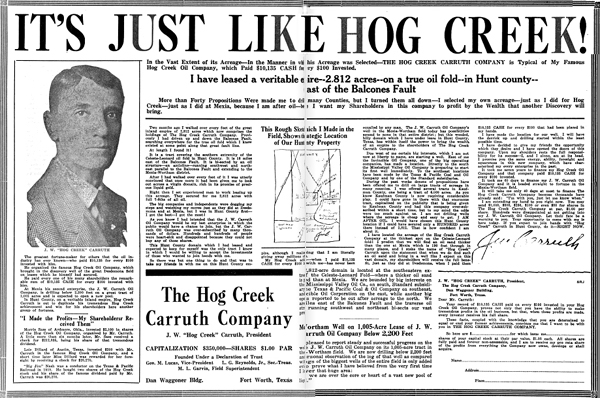
“I have called this company the Hog Creek Carruth Company, since it resembled so closely the famous Hog Creek Oil Company which I organized in 1917 and which in 1918 paid $10,135 cash dividends for every $100 that had been invested in it,” Carruth proclaimed.
Producing a blizzard of full-page promotions in newspapers from Ft. Worth to San Antonio and Port Arthur, the oil stock salesman finally ran afoul of “blue sky” laws, which sought to restrain such scams.
“The advertising of still another promoter, ‘Hog Creek’ Carruth of Fort Worth, Texas, caps the climax,” reported the Providence News on January 3, 1923.
“Modestly he admits that wherever men meet to ‘tell stories of great achievements of the gigantic industry, someone will always tell, amid a breathless silence, the amazing story of Hog Creek Carruth.’”
Indicted in 1923 along with 25 other Texas promoters for “fraudulent use of U.S. mails,” Carruth joined some nationally recognized swindlers.
Among those indicted were some of the most infamous stock promoters of the day: Dr. Frederick Cook, who had falsely claimed to have discovered the North Pole before Robert Perry, and the “genius of bunkum,” Seymour E. J. “Alphabet” Cox, the author of such enticements as, “Oil! Guaranteed Gushers! Five hundred percent, dividends. Pots of gold!”
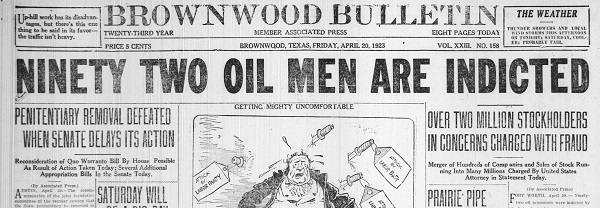 After testimony from almost 300 witnesses and a lengthy trial, Carruth, Cook, Cox and others were convicted of “dispersing stock-sales revenues as dividends, claiming income from non-producing wells, and otherwise misrepresenting the company’s position.”
After testimony from almost 300 witnesses and a lengthy trial, Carruth, Cook, Cox and others were convicted of “dispersing stock-sales revenues as dividends, claiming income from non-producing wells, and otherwise misrepresenting the company’s position.”
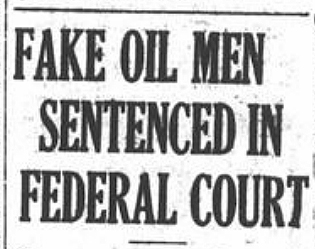 “Hog Creek” Carruth was sent to the Federal Penitentiary in Leavenworth, Kansas for a year. He died in obscurity in 1932.
“Hog Creek” Carruth was sent to the Federal Penitentiary in Leavenworth, Kansas for a year. He died in obscurity in 1932.
In 1934 the Securities and Exchange Commission was established to regulate the issue and sale of securities to protect the public from deceptive stock promotions. Also see the Spear Oil Company and Arctic Explorer turns Oil Promoter.
J.W. “Hog Creek” Carruth’s fraudulent oil ventures (also see Pilgrim Oil Company) have left behind stock certificates as family heirlooms that might some value for some financial certificate collectors. The history of more legitimate exploration companies trying to join petroleum booms (and avoid busts) can be found in Is my Old Oil Stock worth Anything?
_______________________
The American Oil & Gas Historical Society preserves U.S. petroleum history. Join today as an annual AOGHS annual supporting member. Help maintain this energy education website and expand historical research. For more information, contact bawells@aoghs.org. Copyright © 2021 Bruce A. Wells. All rights reserved.
Citation Information – Article Title: “Hog Creek Carruth Oil Company.” Authors: B.A. Wells and K.L. Wells. Website Name: American Oil & Gas Historical Society. URL: https://aoghs.org/oil-almanac/oil-riches-of-merriman-baptist-church. Last Updated: September 9, 2021. Original Published Date: March 11, 2018.
.
by Bruce Wells | Oct 5, 2013 | Petroleum Companies

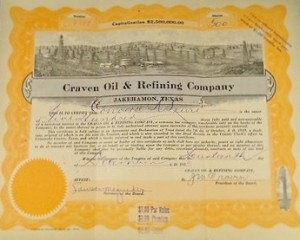 Soon after World War I, the son of a famous general sought opportunities to get rich in the booming oilfields of Texas.
Soon after World War I, the son of a famous general sought opportunities to get rich in the booming oilfields of Texas.
Leonard Wood Jr. was the son of Major Gen. Leonard Wood, a famed Medal of Honor recipient and former chief of staff of the Army. Wood also was a veteran of military service, having served in the Great War as a lieutenant in the 81st Infantry Division. (more…)







(1976); Early Texas Oil: A Photographic History, 1866-1936
(2000); History Of Oil Well Drilling
(2007); Street Lights of the World
(2015); Vertical Reefs: Life on Oil and Gas Platforms in the Gulf of Mexico
(2015); Drilling Technology in Nontechnical Language
(2012); An Illustrated Guide to Gas Pumps
(2008); Schlumberger: The History of a Technique
(1978); Oil in the Deep South: A History of the Oil Business in Mississippi, Alabama, and Florida, 1859-1945
(1993); California State University, Dominguez Hills
(2010). Your Amazon purchase benefits the American Oil & Gas Historical Society. As an Amazon Associate, AOGHS earns a commission from qualifying purchases.




 With oil stock promotions appearing in newspapers nationwide, states began taking action. In August 1919, the attorney general of South Carolina refused Spear Oil Company’s request to sell stock in his state because the company failed to comply with South Carolina “Blue Sky Laws.”
With oil stock promotions appearing in newspapers nationwide, states began taking action. In August 1919, the attorney general of South Carolina refused Spear Oil Company’s request to sell stock in his state because the company failed to comply with South Carolina “Blue Sky Laws.”



 After testimony from almost 300 witnesses and a lengthy trial, Carruth, Cook, Cox and others were convicted of “dispersing stock-sales revenues as dividends, claiming income from non-producing wells, and otherwise misrepresenting the company’s position.”
After testimony from almost 300 witnesses and a lengthy trial, Carruth, Cook, Cox and others were convicted of “dispersing stock-sales revenues as dividends, claiming income from non-producing wells, and otherwise misrepresenting the company’s position.” “Hog Creek” Carruth was sent to the Federal Penitentiary in Leavenworth, Kansas for a year. He died in obscurity in 1932.
“Hog Creek” Carruth was sent to the Federal Penitentiary in Leavenworth, Kansas for a year. He died in obscurity in 1932.

